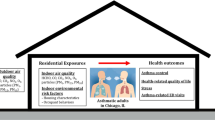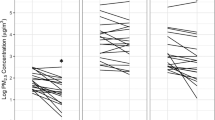Abstract
Previous research has found increased home ventilation, which may affect health by altering the composition of indoor air, is associated with improvement of respiratory health, but evidence linking home ventilation to objectively measured lung function is sparse. The Colorado Home Energy Efficiency and Respiratory health (CHEER) study, a cross-sectional study of low-income, urban, nonsmoking homes across the Northern Front Range of Colorado, USA, focused on elucidating this link. We used a multipoint depressurization blower door test to measure the air tightness of the homes and calculate the annual average infiltration rate (AAIR). Lung function tests were administered to eligible participants. We analyzed data from 253 participants in 187 homes with two or more acceptable spirometry tests. We used generalized estimating equations to model forced expiratory volume in 1 s (FEV1), forced vital capacity (FVC), and FEV1/FVC z-scores as a function of AAIR. AAIRs ranged from 0.10 to 1.98 air changes per hour. Mean z-scores for FEV1, FVC, and FEV1/FVC were −0.57, 0.32, and −0.43, respectively. AAIR was positively associated with increased FEV1/FVC z-scores, such that a 1-unit change in AAIR corresponded to a half of a standard deviation in lung function (β = 0.51, CI: 0.02–0.99). These associations were strongest for healthy populations and weaker for those with asthma and asthma-like symptoms. AAIR was not associated with FEV1 or FVC. Our study is the first in the United States to link home ventilation by infiltration to objectively measured lung function in low-income, urban households.
This is a preview of subscription content, access via your institution
Access options
Subscribe to this journal
Receive 6 print issues and online access
$259.00 per year
only $43.17 per issue
Buy this article
- Purchase on Springer Link
- Instant access to full article PDF
Prices may be subject to local taxes which are calculated during checkout
Similar content being viewed by others
References
Klauss AK, Tull RH, Roots LM, Pafafflin JR. History of changing concepts in ventilation requirements. ASHrAE J. 1970;12:51.
Nazaroff WW. Four principles for achieving good indoor air quality. Indoor Air. 2013;23:353–6.
Fisk WJ. How home ventilation rates affect health: a literature review. Indoor Air. 2018;28:473–87.
Sundell J, Levin H, Nazaroff WW, Cain WS, Fisk WJ, Grimsrud DT, et al. Ventilation rates and health: multidisciplinary review of the scientific literature. Indoor Air. 2011;21:191–204.
Wargocki P. The effects of ventilation in homes on health. Int J Vent. 2013;12:101–18.
Hodas N, Meng Q, Lunden MM, Rich DQ, Ozkaynak H, et al. Variability in the fraction of ambient fine particulate matter found indoors and observed heterogeneity in health effect estimates. J Expo Sci Environ Epidemiol. 2012;22:448–54.
Carlton EJ, Barton K, Shrestha PM, Humphrey J, Newman LS, Adgate JL, et al. Relationships between home ventilation rates and respiratory health in the Colorado Home Energy Efficiency and Respiratory Health (CHEER) study. Environ Res. 2018;169:297–307.
Wang J, Engvall K, Smedje G, Nilsson H, Norback D. Current wheeze, asthma, respiratory infections, and rhinitis among adults in relation to inspection data and indoor measurements in single-family houses in Sweden-The BETSI study. Indoor Air. 2017;27:725–36.
Francisco PW, Jacobs DE, Targos L, Dixon SL, Breysse J, Rose W, et al. Ventilation, indoor air quality, and health in homes undergoing weatherization. Indoor Air. 2017;27:463–77.
Oie L, Nafstad P, Botten G, Magnus P, Jaakkola JJK. Ventilation in homes and bronchial obstruction in young children. Epidemiology. 1999;10:249–99.
Wilson J, Dixon SL, Jacobs DE, Breysse J, Akoto J, Tohn E, et al. Watts-to-Wellbeing: does residential energy conservation improve health? Energy Efficiency. 2014;7:151–60.
Bornehag CG, Sundell J, Hagerhed-Engman L, Sigsgaard T. Association between ventilation rates in 390 Swedish homes and allergic symptoms in children. Indoor Air. 2005;15:275–80.
Emenius G, Svartengren M, Korsgaard J, Nordvall L, Pershagen G, Wickman M. Building characteristics, indoor air quality and recurrent wheezing in very young children (BAMSE). Indoor Air. 2004;14:34–42.
Isaacs K, Burke J, Smith L, Williams R. Identifying housing and meteorological conditions influencing residential air exchange rates in the DEARS and RIOPA studies: development of distributions for human exposure modeling. J Expo Sci Environ Epidemiol. 2013;23:248–58.
Lajoie P, Aubin D, Gingras V, Daigneault P, Ducharme F, Gauvin D, et al. The IVAIRE project-a randomized controlled study of the impact of ventilation on indoor air quality and the respiratory symptoms of asthmatic children in single family homes. Indoor Air. 2015;25:582–97.
Wright GR, Howieson S, McSharry C, McMahon AD, Chaudhuri R, Thompson J, et al. Effect of improved home ventilation on asthma control and house dust mite allergen levels. Allergy. 2009;64:1671–80.
Warner JA, Frederick JM, Bryant TN, Weich C, Raw GJ, Hunter C, et al. Mechanical ventilation and high-efficiency vacuum cleaning: a combined strategy of mite and mite allergen reduction in the control of mite-sensitive asthma. J Allergy Clin Immunol. 2000;105:75–82.
U.S. Environmental Protection Agency. Report to Congress on indoor air quality: volume 2. Washington, DC: U.S. Environmental Protection Agency; 1989.
U.S. Department of Housing and Urban Development (HUD). Glossary of CPD terms - low income. Washington, D.C., U.S: U.S. Department of Housing and Urban Development; 2016. https://www.hud.gov/program_offices/comm_planning/library/glossary/l.
Sherman MH, Grimsrud DT. Measurement of infiltration using fan pressurization and weather data. Washington, D.C., U.S: Lawrence Berkeley National Laboratory; 1980.
The Energy Conservatory. Minneapolis Blower Door System with DG-1000. Washington, D.C., U.S: The Energy Conservatory; 2015.
Canadian General Standards Board. Determination of the airtightness of building envelopes by the fan depressurization method. Ottawa, CA: Canadian General Standards Board; 1986.
Palmiter L, Bond T. Interaction of mechanical systems and natural infiltration. In: AIVC Conference On Air Movement and Ventilation Control Within Buildings; Ottawa, Canada; 1991.
Shrestha PM, Humphrey JL, Barton KE, Carlton EJ, Adgate JL, Root ED, et al. Impact of low-income home energy-efficiency retrofits on building air tightness and healthy home indicators. Sustainability. 2019;11:2667–89.
The National Institue for Occupational Safety and Health (NIOSH). Spirometry Training Program. Washington, D.C., U.S: The National Institue for Occupational Safety and Health; 2017. https://www.cdc.gov/niosh/topics/spirometry/training.html.
NDD Medical Technologies Inc. EasyOne Plus Spirometer. Andover, MA, USA: NDD Medical Technologies Inc; 2017.
Miller MR, Hankinson J, Brusasco V, Burgos F, Casaburi R, et al. Standardisation of spirometry. Eur Respir J. 2005;26:319–38.
Eisen EA, Robins JM, Greaves IA, Wegman DH. Selection effects of repeatability criteria applied to lung spirometry. Am J Epidemiol 1984;120:734–42.
Quanjer PH, Stanojevic S, Cole TJ, Baur X, Hall GL, Culver BH, et al. Multi-ethnic reference values for spirometry for the 3–95-yr age range: the global lung function 2012 equations. Eur Respir J. 2012;40:1324–43.
Centers for Disease Control and Prevention. National Health and Nutrition Examination Survey Questionnaire, 2011–2012. Washington, D.C., U.S: Centers for Disease Control and Prevention; 2012. https://wwwn.cdc.gov/nchs/nhanes/continuousnhanes/questionnaires.aspx?BeginYear=2011.
Eisner MD, Blanc PD, Omachi TA, Yelin EH, Sidney S, Katz PP, et al. Socioeconomic status, race and COPD health outcomes. J Epidemiol Community Health. 2011;65:26–34.
Garrett MH, Hooper MA, Hooper BM, Abramson MJ. Respiratory symptoms in children and indoor exposure to nitrogen dioxide and gas stoves. Am J Respir Crit Care Med. 1998;158:891–5.
Jenkins CR, Celli B, Anderson JA, Ferguson GT, Jones PW, et al. Seasonality and determinants of moderate and severe COPD exacerbations in the TORCH study. Eur Respir J. 2012;39:38–45.
Carlsen HK, Modig L, Levinsson A, Kim JL, Toren K, Nyberg F, et al. Exposure to traffic and lung function in adults: a general population cohort study. BMJ Open. 2015;5:e007624.
Zeger S, Kung-Yee L, Albert P. Models for longitudinal data: a generalized estimating equation approach. Biometrics. 1988;44:1049–60.
Guarnieri M, Balmes JR. Outdoor air pollution and asthma. Lancet. 2014;383:1581–92.
Lewis SA, Weiss ST, Platts-Mills TAE, Burge H, Gold DR. The rold of indoor allergen sensitization and exposure in causing morbidity in women with asthma. Am J Respir Crit Care Med. 2002;165:961–6.
Maçãira EdF, Algranti E, Stelmach R, Ribeiro M, Nunes MdPT, Mendonça EMC, et al. Determinação de escore e nota de corte do módulo de asma do International Study of Asthma and Allergies in Childhood para discriminação de adultos asmáticos em estudos epidemiológicos. Jornal Brasileiro de. Pneumologia. 2005;31:477–85.
SAS Institute Inc. SAS Version 9.4. Cary, NC: SAS Institute Inc; 2014.
Pellegrino R, Viegi G, Brusasco V, Crapo R, Burgos F, Casaburi R, et al. Interpretave strategies for lung function tests. Eur Respir J. 2005;26:948–68.
Hegewald MJ, Crapo RO. Socioeconomic status and lung function. Chest. 2007;132:1608–14.
Sherman MH, WIlson DJ, Kiel DE. Variability in residential air leakage. Measured air leakage of buildings. Washington, D.C., U.S: ASTM International; 1986.
Acknowledgements
This research was developed under Assistance Agreement No. RD 83575201 awarded by the U.S. Environmental Protection Agency to SLM. It has not been formally reviewed by EPA. The views expressed in this document are solely those of the authors and do not necessarily reflect those of the Agency. EPA does not endorse any products or commercial services mentioned in this publication. We thank Xcel Energy, Boulder Housing Partners, and Loveland Habitat for Humanity with their assistance in recruiting study participants. We also thank Megan Lindstrom, Sam Rock, Adam Pittman, Ethan Zerpa, Adam Hahn, Hanadi Salamah, Tess Bloom, Ryan Hourigan, Mohamad Eltarkawe, Olivia Cecil, Jonathan Kohlenberg, Alisen Bol, Adam Hester, Sarah Hong, Alex Mass, and Stefano Brunelli for their assistance with field data collection.
Author information
Authors and Affiliations
Corresponding author
Ethics declarations
Conflict of interest
The authors declare that they have no conflict of interest.
Additional information
Publisher’s note Springer Nature remains neutral with regard to jurisdictional claims in published maps and institutional affiliations.
Supplementary information
Rights and permissions
About this article
Cite this article
Humphrey, J.L., Barton, K.E., Man Shrestha, P. et al. Air infiltration in low-income, urban homes and its relationship to lung function. J Expo Sci Environ Epidemiol 30, 262–270 (2020). https://doi.org/10.1038/s41370-019-0184-8
Received:
Revised:
Accepted:
Published:
Issue Date:
DOI: https://doi.org/10.1038/s41370-019-0184-8
Keywords
This article is cited by
-
New approach to soil management focusing on soil health and air quality: one earth one life (critical review)
Environmental Geochemistry and Health (2023)



